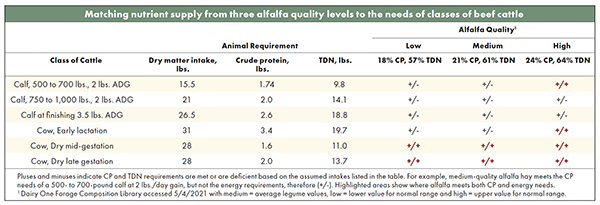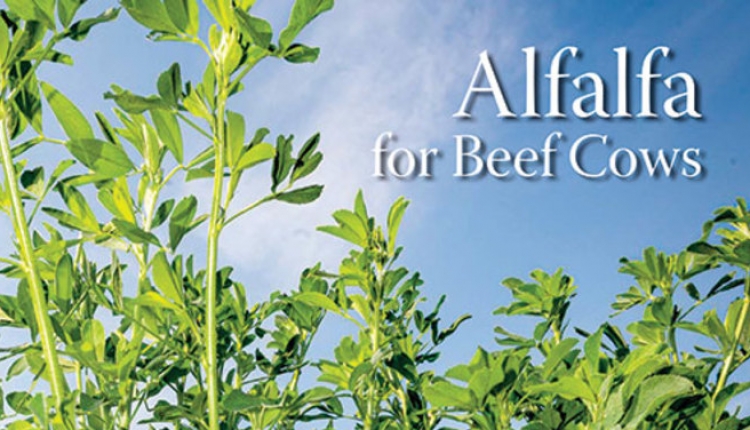Beef benefits from alfalfa |
| By Hay and Forage Grower |
|
|
|
Hay & Forage Grower is featuring results of research projects funded through the Alfalfa Checkoff, officially named the U.S. Alfalfa Farmer Research Initiative, administered by National Alfalfa & Forage Alliance (NAFA). The checkoff program facilitates farmer-funded research.  Ray Smith Funding: $9,464 A change in mindset toward alfalfa is needed, he said. “People automatically think of alfalfa for dairy cows, and, in Kentucky at least, the common adage is, ‘Beef cows? Any old hay will do,’” Smith added. Hay cost, not hay quality, has been the determining factor when feeding beef cattle, particularly by small-operation producers. “The top beef producers know what quality is and the importance of ration balancing. But so many smaller beef cattle operators are either feeding based on tradition or are new to the market, maybe transitioning out of crop production or moving to the country and wanting some beef cows,” the specialist explained. “That average producer often isn’t thinking about forage quality.” To help shift their thinking, Smith and his colleagues completely revised a 30-year-old publication called Alfalfa for Beef Cows using Alfalfa Checkoff funding. They added detailed information on alfalfa’s value as a homegrown protein and energy source that can also provide cattle needed vitamins and minerals. The specialists highlighted new research showing the nitrogen-fixing legume can be successfully interseeded into bermudagrass to extend stand life, boost forage production, and improve quality. It can be harvested as hay or baleage or be grazed. Adding alfalfa to the mix can extend the grazing season. If alfalfa is at least 30% of the stand, no supplemental nitrogen is required, even though bermudagrass and cool-season grasses need substantial nitrogen applications for top production. An alfalfa-grass mixture can improve forage intake, dietary nutritional value, and animal performance, according to the 12-page publication. It also cuts back on the amount of feed supplementation needed. The booklet recommends matching forage quality to animal class to ensure nutritional needs are met. Beef cows in early lactation, growing heifers, weaned calves, and low body condition adult animals — all with higher nutrient needs — thrive on alfalfa or alfalfa-grass mixes. Alfalfa can also be fed to young nursing calves through creep grazing or in creep pens to boost nutrient uptake and limit-fed to mature animals during winter for additional protein and energy.  “Often, I get the comment, ‘I don’t really need a high-quality hay because I’m just trying to maintain my animals,’” Smith said. “There are a number of ways you can limit-feed high-quality hay. Limit the amount of time they have access to it. Many people are unrolling the hay and calculating how much of the ration that’s going to be. “Beef cattle don’t need nutrition maintained at high levels on a daily basis like dairy cows. They can be given a high protein through alfalfa one day and then reduced protein the next day,” he said. The publication includes information on alfalfa harvest management, summer and fall grazing, grazing throughout the growing season, and stand persistence. It also gives a concise list of agronomic strategies for producing alfalfa on beef operations as well as resources that contain further information. Smith acknowledges the contributions and expertise of lead authors Jeff Lehmkuhler and Katie VanValin, UK Extension beef specialists, and gives special thanks to other authors, including UK’s Jimmy Henning and Chris Teutsch, extension forage specialists, and Krista Lea, extension research analyst. Jennifer Tucker, University of Georgia Extension animal scientist, wrote the section on integrating alfalfa with bermudagrass. “This publication is telling producers around the country that they should consider a high-quality forage like alfalfa on some of their acres if they have the soil to grow it. When buying hay, look at the top-quality offerings. There’s a pretty good chance it will be alfalfa,” Smith said.  Project Results Completely revised the 1991 publication, Alfalfa for Beef Cows, offering detailed information on the value of the legume, best management practices, updated photographs, and recently published data. This article appeared in the April/May 2022 issue of Hay & Forage Grower on pages 14 & 15. Not a subscriber? Click to get the print magazine. |
